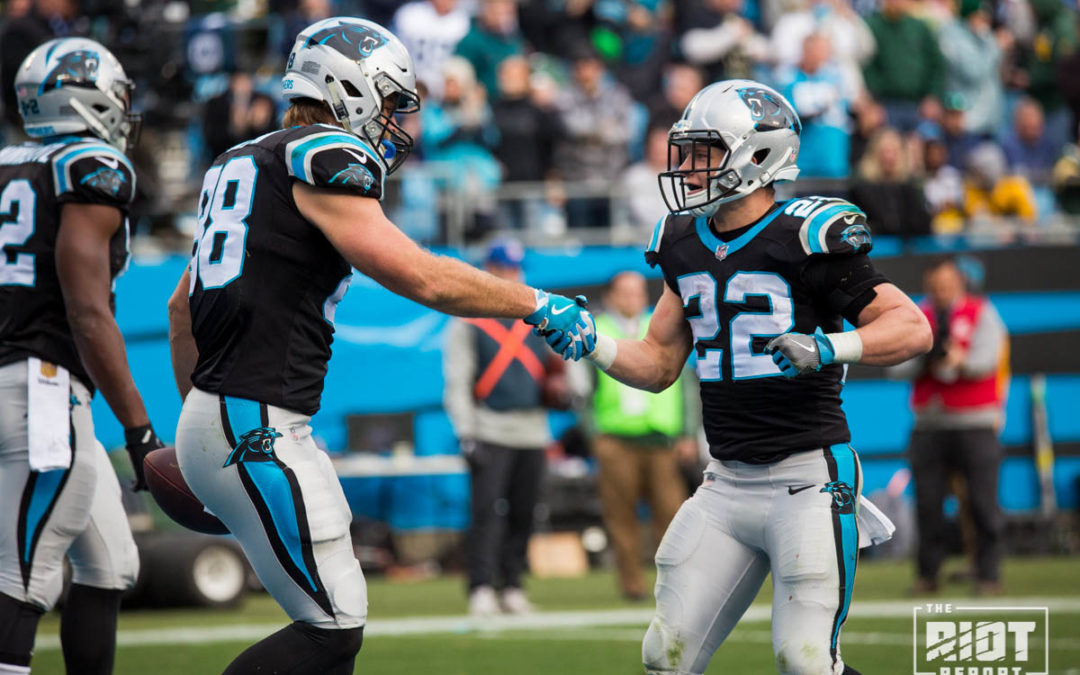Christian McCaffrey had one of his best days of his young career on Sunday, putting up 136 yards on 18 total touches with a viral touchdown to boot; while some of that can be attributed to a suspect Green Bay defense, it was mostly due to the Panthers’ growing understanding how to use their new toy effectively. While not everything they tried on Sunday worked, how should the Panthers continue to adapt their gameplan in order to get the most out of McCaffrey?
Run Game
While much of the focus of McCaffrey’s value has been on his receiving ability, his value as a runner cannot be ignored; on Sunday, the Panthers managed to maximize his value in this area. Unlike Stewart, McCaffrey rarely picks up additional yards after contact, so running plays with McCaffrey on the field must aim to create clear running room, either in the form of an interior seam or by getting him outside of the defense.
The easiest way of doing this, and something the Panthers have used successfully throughout the second half of the season, is by using him on toss plays. Here, McCaffrey quickly gets the ball in his hands; this is the major advantage of the toss compared to stretch plays, it allows him to use his field vision to cut a running lane through the defenders, such as on the following play.
This play allows the Panthers to take advantage of the Packers adopting an uneven formation with an excess of defenders on the far side of the field. However, even when this is not the case, the Panthers have to look to more complex methods of creating space for McCaffrey. The following play involves the offensive line ‘crashing’ to the left (or right on the screen) with Olsen clearing out the back-side defender and Shepard’s kick-back block creating the seam inside of the right guard.
While this play works very well, it places too much responsibility on both Olsen and Shephard to make difficult blocks in order to create a running lane. The Panthers tried to use a similar play later in the game, with Williams and Olsen kicking out the back-side defenders and Funchess creating the sealing block to run outside to the right (left on the screen). Here, Olsen is unable to clear the player out and the play effectively implodes.
What this play does well is capitalize on McCaffrey’s ability to get downfield quickly, with the seam only looking to be created for a short period of time. While this does mean that missed blocks by the kick-out blockers can blow up the play by allowing that window to close, it allows the Panthers to run the ball effectively against loaded boxes without expecting super-human feats by members of the offensive line. If the Panthers want to continue to have success with this concept, it will require Cam to get even better pre-snap.
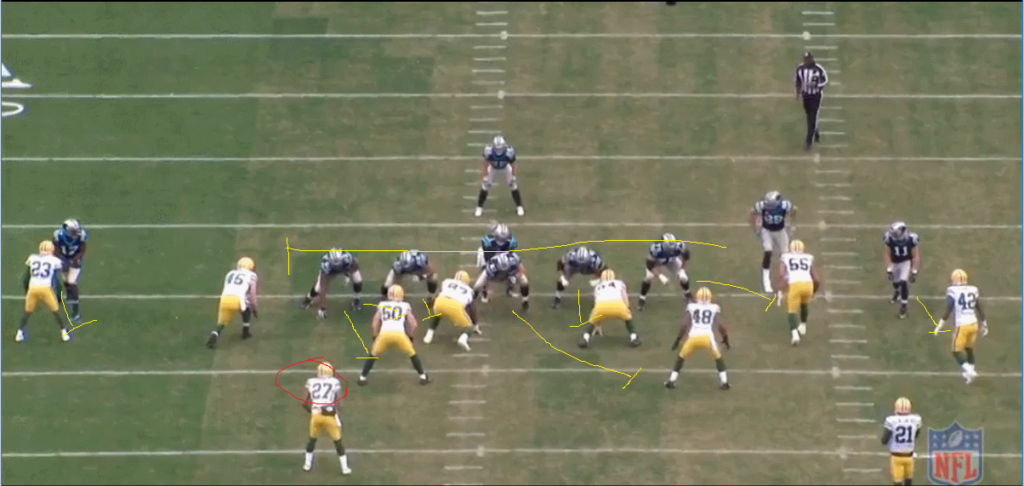
![]() The above image shows the defensive alignment pre-snap, with the read defender being the safety highlighted by the red circle. As the safety is lined up inside the tackle box, Newton could have optioned to the jet sweep, looking to take advantage of the speed mismatch against the safety. While Olsen’s missed block and good play by Blake Martinez (#50) led to this run being snuffed, the Panthers need to further improve how they use these pre-snap options if they want to get the most out of plays like this.
The above image shows the defensive alignment pre-snap, with the read defender being the safety highlighted by the red circle. As the safety is lined up inside the tackle box, Newton could have optioned to the jet sweep, looking to take advantage of the speed mismatch against the safety. While Olsen’s missed block and good play by Blake Martinez (#50) led to this run being snuffed, the Panthers need to further improve how they use these pre-snap options if they want to get the most out of plays like this.
Another way to get McCaffrey the ball with space to run is through the use of post-snap options, most notably, read options and triple options. As Newton has reemerged as a runner during the latter half of the season, the Panthers have been able to use these types of plays more and more to exploit uncertainty in the defense. The following play is an example of the read option:
Here, the safety is covering Olsen with the likely option to be a straight block if the safety doesn’t drop into coverage; the right side of the offensive line all crash right and the read is operating on the left side of the formation, shown on the diagram below:
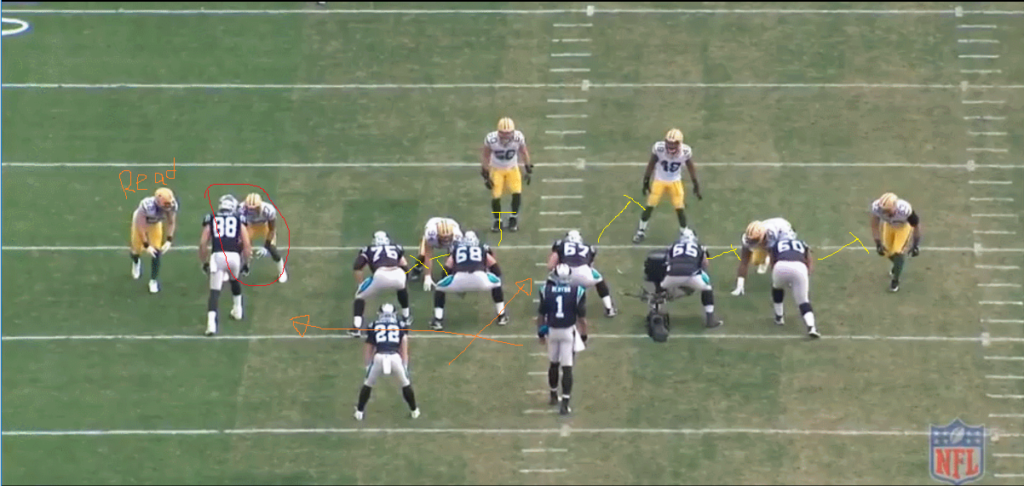
Norwell and Matt Kalil are tasked with doubling the tackle, with one of them kicking up to the linebacker; Newton then has to read the outside linebacker, with the hesitation leading to the handoff. Again, Martinez does a good job here and likely prevents an even longer run, but this still leads to a positive play for the Panthers with limited complexity.
As well as the simple read option, the Panthers have also looked to use McCaffrey out of the triple option, both as the base-read and as the toss option. On the following play, the Panthers are aided by the near side safety bailing early, allowing Cam to simply read the end before tossing the ball to McCaffrey for the big gain:
However, on the next play, with McCaffrey being used as the base-read, the safety stays down and Newton is asked to read two defenders at once:
Here, both the safety and linebacker on the right of the screen hesitate and Newton hands the ball off to McCaffrey. Had the linebacker crashed the base run, Newton would have pulled the ball and progressed to read the safety on what is essentially a speed option; all of which is shown on the next diagram:
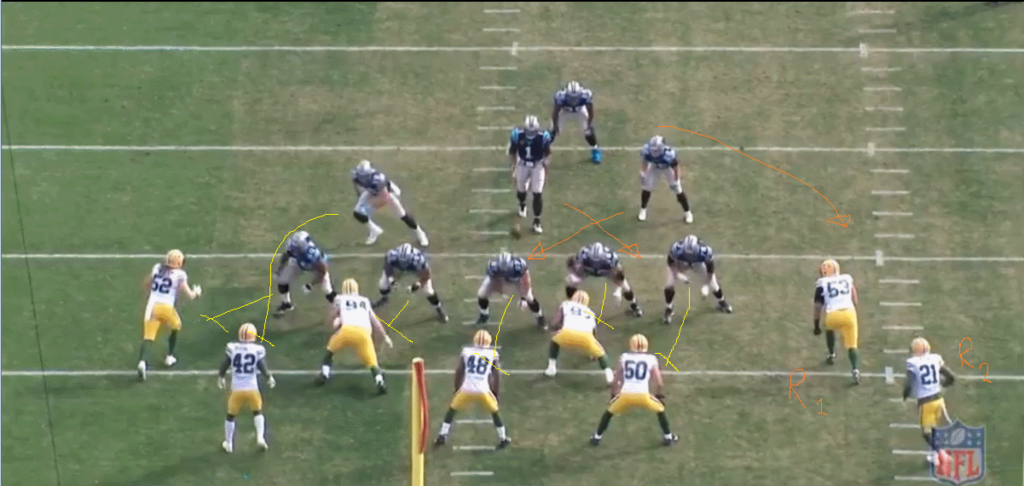
Had Norwell and Williams been able to sustain their blocks, this play might have gone for even more yardage, but by being able to take advantage of the threat of Newton the runner, the Panthers are able to generate easy running room for all of their running backs, but McCaffrey’s turn of pace is especially effective when it comes to taking advantage of even the slightest hesitations by defenders.
The latest twist in the Panthers option game was hinted at during Sunday’s game: the McCaffrey pass. On the following play, the Panthers run a standard stretch play, only with McCaffrey being asked to read the linebacker covering Olsen. Had he come down to try and seal the edge, McCaffrey would have had the option to throw the ball to Olsen but because he didn’t, he is able to use this hesitation to get to the edge for an easy gain. Fans shouldn’t expect to see McCaffrey airing it out on a regular occasion, but run-pass reads like this have been shown success at the college level, McCaffrey did complete two passes in college.
Both went for touchdowns.
While McCaffrey is unlikely to be asked to carry the ball 20 times per game for the Panthers, he has a valuable skill set as a ball carrier when given opportunities suited to him; if the Panthers can continue to improve how they look to use him in this way then rushing statistics like those of Sunday, twelve carries for sixty-three yards, could be a regular feature.
Passing Game
Much has already been written about how the Panthers have looked to use McCaffrey as a receiver out of the backfield, including on the touchdown against the Packers, but what may have been more notable on Sunday was the increased usage of McCaffrey as a split-out receiver. This certainly isn’t the first time this season they have done so, but it is possibly the most varied showing we have seen from McCaffrey, the receiver.
The most common use of McCaffrey as a receiver throughout the season has been on simple out routes, especially on third and fourth downs; such as the following play:
This makes the most of McCaffrey’s short-area quickness as the defender is forced to hesitate at the head of the route waiting for McCaffrey to break either inside or out. The Panthers also had some success on Sunday on a pure receiver route, with McCaffrey being asked to get vertical before breaking back outside to the ball. While this route doesn’t create as much separation, McCaffrey shows good hands in making a contested catch along the endline:
In order to improve the separation, McCaffrey could possibly push harder to the head of the route, using this as an option route in case the defender commits underneath. Regardless, this was one of the first times McCaffrey has been lined up outside and been asked to run routes like a standard wideout, something that might become a more regular feature as the season goes on.
The one passing play where the Panthers were unsuccesful in trying to use McCaffrey was on a third-and-nine play inside their own twenty-yard line. Here they keep Dickson in as an extra blocker against the Packers’ drop back zone:
The issue here is that with Olsen and McCaffrey both running to the center of the field, this area becomes congested and McCaffrey is forced to slow down after his break, thereby allowing the defender to catch up. While a perfectly thrown ball by Cam might have allowed for the completion, plays like this could see some improvement.
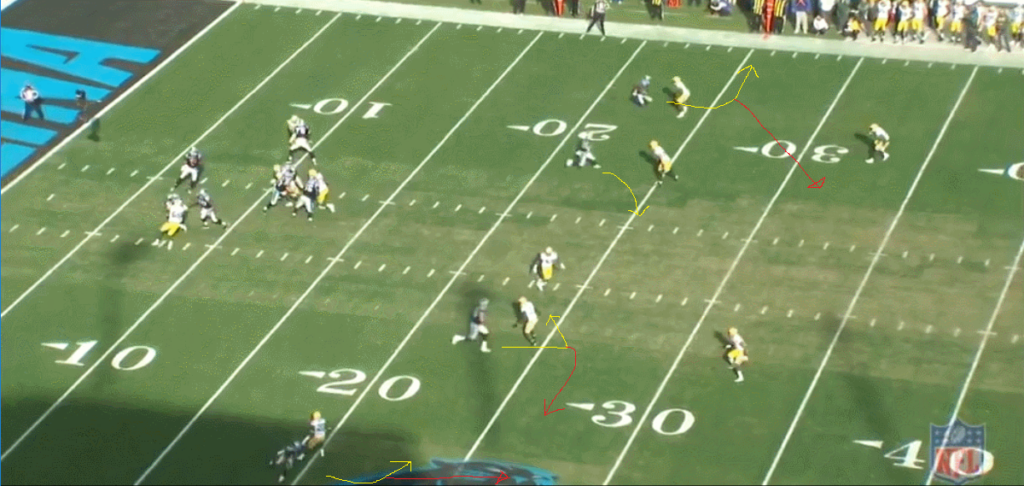
On this diagram, the routes run are shown in yellow, with the proposed changes being shown in red. The combination of the Olsen deep out and the Byrd go routes (this might have been what he actually ran but he appears to slow near the top of his route as the ball is thrown) would force overage to the outside and allow for an easy completion; this would also create more space for McCaffrey to run into with the Funchess deep post forcing the far side safety up the field. By adding additional verticality to the routes, it prevents the defense from sitting at the down marker for the routes’ break points.
While it shouldn’t be surprising that the Panthers’ game plan for McCaffrey is an ongoing development, it is exciting to see how they have continued to refine their use of him. As the season enters its latter stages this, along with the return to health of Greg Olsen and Ryan Kalil, could be a significant factor in the Panthers’ final push to the playoffs, and perhaps, beyond.

